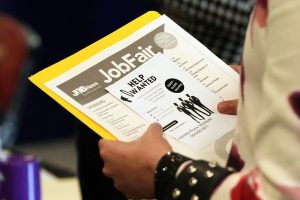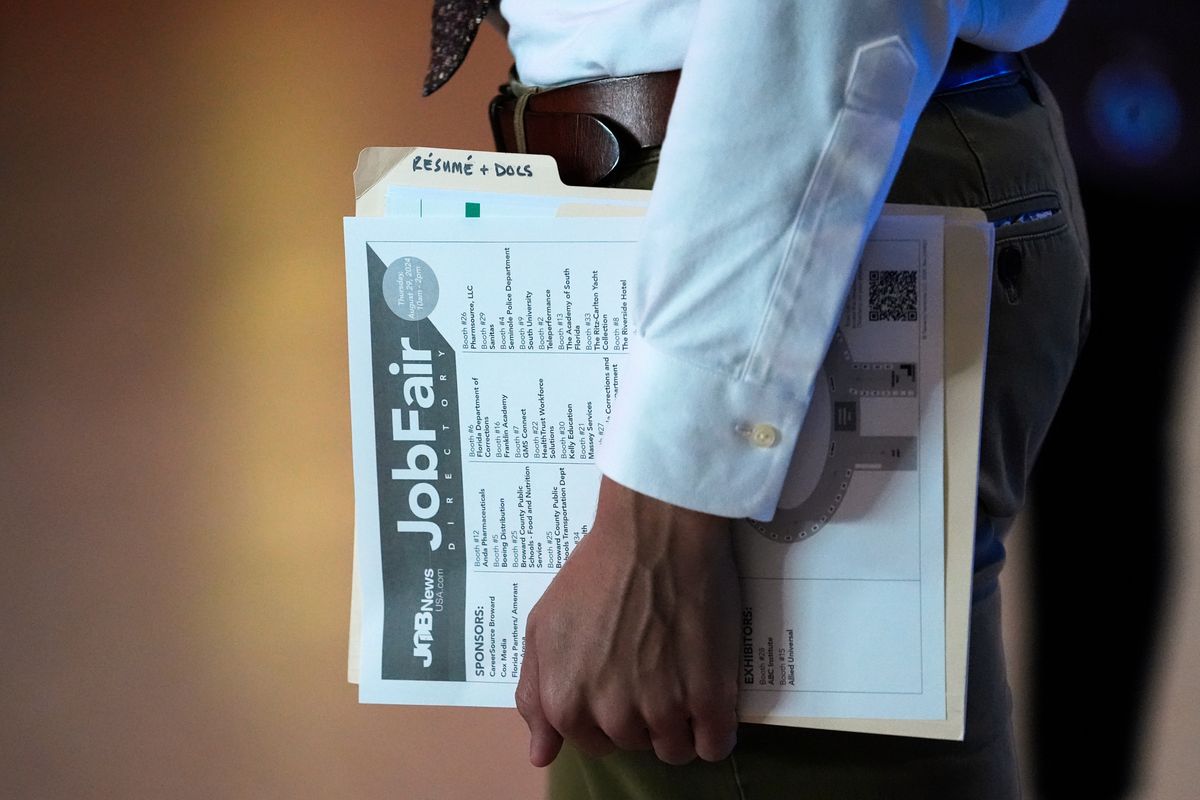WASHINGTON (AP) — When Carly Kaprive left a job in Kansas City and moved to Chicago a year ago, she figured it would take three to six months to find a new position. After all, the 32-year old project manager had never been unemployed for longer than three months.
Instead, after 700 applications, she’s still looking, wrapped up in a frustrating and extended job hunt that is much more difficult than when she last looked for work just a couple of years ago. With uncertainty over interest rates, tariffs, immigration, and artificial intelligence roiling much of the economy, some companies she’s interviewed with have abruptly decided not to fill the job at all.
“I have definitely had mid-interview roles be eliminated entirely, that they are not going to move forward with even hiring anybody,” she said.
Kaprive is caught in a historical anomaly: The unemployment rate is low and the economy is still growing, but those out of work face the slowest pace of hiring in more than a decade. Diane Swonk, chief economist at KPMG, calls it a “jobless boom.”
While big corporate layoff announcements typically grab the most attention, it has been the unwillingness of many companies to add workers that has created a more painful job market than the low 4.3% unemployment rate would suggest. It is also more bifurcated: The “low hire, low fire” economy has meant fewer layoffs for those with jobs, while the unemployed struggle to find work.
“It’s like an insider-outsider thing,” Guy Berger, head of research at the Burning Glass Institute said, “where outsiders that need jobs are struggling to get their foot in, even as insiders are insulated by what up until now is a low-layoff environment.”
Several large companies have recently announced tens of thousands of job cuts in the past few weeks, including UPS, Target, and IBM, though Berger said it is too soon to tell whether they signal a turn for the worse in the economy. But a rise in job cuts would be particularly challenging with hiring already so low.
For now, it’s harder than ever to get a clear read on the job market because the government shutdown has cut off the U.S. Department of Labor’s monthly employment reports. The October jobs report was scheduled for release Friday but has been delayed, like the September figures before it. The October report may be less comprehensive when it is released because not all the data may be collected.
Before the shutdown, the Labor Department reported that the hiring rate — the number of people hired in a given month, as a percentage of those employed — fell to 3.2% in August, matching the lowest figure outside the pandemic since March 2013.
Back then, the unemployment rate was a painful 7.5%, as the economy slowly recovered from the job losses from the 2008-2009 Great Recession. That is much higher than August’s 4.3%.
Many of those out of work are skeptical of the current low rate. Brad Mislow, 54, has been mostly unemployed for the past three years after losing a job as an advertising executive in New York City. Now he is substitute teaching to make ends meet.
“It is frustrating to hear that the unemployment rate is low, the economy is great,” he said. “I think there are people in this economy who are basically fighting every day and holding on to pieces of flotsam in the shark-filled waters or, they have no idea what it’s like.”
With the government closed, financial markets are paying closer attention to private-sector data, but that is also mixed. On Thursday, the outplacement firm Challenger, Gray & Christmas unnerved investors with a report that announced job cuts surged 175% in October from a year ago.
Yet on Wednesday, payroll processor ADP said that net hiring picked up in October as businesses added 42,000 jobs, after two months of declines. Still, the gain was modest. ADP’s figures are based on anonymous data from the 26 million workers at its client companies.
Separately, Revelio Labs, a workplace analytics company, estimated Thursday that the economy shed 9,000 jobs in October. The Federal Reserve Bank of Chicago estimates that the unemployment rate ticked up to 4.4% last month.
Even when the government was releasing data, economists and officials at the Federal Reserve weren’t sure how healthy the job market was or where it was headed next. A sharp drop in immigration and stepped-up deportations have helped keep the unemployment rate low simply by reducing the supply of workers. The economy doesn’t need to create as many jobs to keep the unemployment rate from rising.
Jerome Powell, chair of the Federal Reserve, has called in a “curious balance” because both the supply of and demand for workers has fallen.
Economists point to many reasons for the hiring slowdown, but most share a common thread: Greater uncertainty from tariffs, the potential impact of artificial intelligence, and now the government shutdown. While investment in data centers to power AI is booming, elevated interest rates have kept many other parts of the economy weak, such as manufacturing and housing.
“The concentration of economic gains (in AI) has left the economy looking better on paper than it feels to most Americans,” Swonk said.
Recent college graduates have borne the brunt of the hiring slowdown, but it’s been a struggle for workers at all ages.
Suzanne Elder, 65, is an operations executive with extensive experience in health care, and two years ago the Chicago resident also found work quickly when she sought to switch jobs. She had three job offers within three months. But now she’s been unemployed ever since a layoff in April.
She is worried that her age is a challenge, but isn’t letting it hold her back. “I got a job at 63, so I don’t see a reason to not get a job at 65,” she said.
Like many job-hunters, she has been stunned by the impersonal responses from recruiters, often driven by hiring software. She received one email from a company that thanked her for speaking with them, though she never had an interview. Another company that never responded to her resume asked her to fill out a survey about their interaction.
Weak hiring has meant unemployment spells are getting longer, according to government data. More than one-quarter of those out of work have been unemployed for more than six months or longer, a figure that rose sharply in July and August and is up from 21% a year ago.
Swonk said that such increases are unusual outside recessions.
A rising number of the unemployed have also given up on their job searches, according to research by the Federal Reserve Bank of Minneapolis. That also holds down the unemployment rate because people who stop looking aren’t counted as unemployed.
But Kaprive is still sticking with it — she’s taken classes about Amazon’s web services platform to boost her technology skills.
“We can’t be narrow-minded in what we’re willing to take,” she said.
By CHRISTOPHER RUGABER
AP Economics Writer


